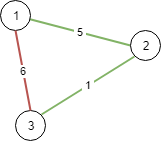想象一下你是个城市基建规划者,地图上有 N 座城市,它们按以 1 到 N 的次序编号。
给你一些可连接的选项 conections,其中每个选项 conections[i] = [city1, city2, cost] 表示将城市 city1 和城市 city2 连接所要的成本。(连接是双向的,也就是说城市 city1 和城市 city2 相连也同样意味着城市 city2 和城市 city1 相连)。
返回使得每对城市间都存在将它们连接在一起的连通路径(可能长度为 1 的)最小成本。该最小成本应该是所用全部连接代价的综合。如果根据已知条件无法完成该项任务,则请你返回 -1。
示例 1:
输入:N = 3, conections = [[1,2,5],[1,3,6],[2,3,1]] 输出:6 解释: 选出任意 2 条边都可以连接所有城市,我们从中选取成本最小的 2 条。
示例 2:
输入:N = 4, conections = [[1,2,3],[3,4,4]] 输出:-1 解释: 即使连通所有的边,也无法连接所有城市。
提示:
1 <= N <= 100001 <= conections.length <= 100001 <= conections[i][0], conections[i][1] <= N0 <= conections[i][2] <= 10^5conections[i][0] != conections[i][1]
最小生成树 + 并查集。
并查集模板:
模板 1——朴素并查集:
# 初始化,p存储每个点的父节点
p = list(range(n))
# 返回x的祖宗节点
def find(x):
if p[x] != x:
# 路径压缩
p[x] = find(p[x])
return p[x]
# 合并a和b所在的两个集合
p[find(a)] = find(b)模板 2——维护 size 的并查集:
# 初始化,p存储每个点的父节点,size只有当节点是祖宗节点时才有意义,表示祖宗节点所在集合中,点的数量
p = list(range(n))
size = [1] * n
# 返回x的祖宗节点
def find(x):
if p[x] != x:
# 路径压缩
p[x] = find(p[x])
return p[x]
# 合并a和b所在的两个集合
if find(a) != find(b):
size[find(b)] += size[find(a)]
p[find(a)] = find(b)模板 3——维护到祖宗节点距离的并查集:
# 初始化,p存储每个点的父节点,d[x]存储x到p[x]的距离
p = list(range(n))
d = [0] * n
# 返回x的祖宗节点
def find(x):
if p[x] != x:
t = find(p[x])
d[x] += d[p[x]]
p[x] = t
return p[x]
# 合并a和b所在的两个集合
p[find(a)] = find(b)
d[find(a)] = distanceclass Solution:
def minimumCost(self, n: int, connections: List[List[int]]) -> int:
p = list(range(n))
connections.sort(key=lambda x: x[2])
res = 0
def find(x):
if p[x] != x:
p[x] = find(p[x])
return p[x]
def union(a, b):
pa, pb = find(a - 1), find(b - 1)
if pa == pb:
return False
p[pa] = pb
return True
for c1, c2, cost in connections:
if union(c1, c2):
n -= 1
res += cost
if n == 1:
return res
return -1class Solution {
private int[] p;
public int minimumCost(int n, int[][] connections) {
p = new int[n];
for (int i = 0; i < n; ++i) {
p[i] = i;
}
Arrays.sort(connections, (a, b) -> a[2] - b[2]);
int res = 0;
for (int[] e : connections) {
if (union(e[0], e[1])) {
res += e[2];
--n;
if (n == 1) {
return res;
}
}
}
return -1;
}
private int find(int x) {
if (p[x] != x) {
p[x] = find(p[x]);
}
return p[x];
}
private boolean union(int a, int b) {
int pa = find(a - 1), pb = find(b - 1);
if (pa == pb) {
return false;
}
p[pa] = pb;
return true;
}
}class Solution {
public:
vector<int> p;
int minimumCost(int n, vector<vector<int>> &connections) {
p.resize(n);
for (int i = 0; i < n; ++i) p[i] = i;
auto cmp = [](auto &a, auto &b)
{
return a[2] < b[2];
};
sort(connections.begin(), connections.end(), cmp);
int res = 0;
for (auto e : connections)
{
if (unite(e[0], e[1]))
{
res += e[2];
--n;
if (n == 1) return res;
}
}
return -1;
}
int find(int x) {
if (p[x] != x) p[x] = find(p[x]);
return p[x];
}
bool unite(int a, int b) {
int pa = find(a - 1), pb = find(b - 1);
if (pa == pb) return false;
p[pa] = pb;
return true;
}
};var p []int
func minimumCost(n int, connections [][]int) int {
p = make([]int, n)
for i := 0; i < len(p); i++ {
p[i] = i
}
sort.Slice(connections, func(i, j int) bool {
return connections[i][2] < connections[j][2]
})
res := 0
for _, e := range connections {
if union(e[0], e[1]) {
res += e[2]
n--
if n == 1 {
return res
}
}
}
return -1
}
func find(x int) int {
if p[x] != x {
p[x] = find(p[x])
}
return p[x]
}
func union(a, b int) bool {
pa, pb := find(a-1), find(b-1)
if pa == pb {
return false
}
p[pa] = pb
return true
}

